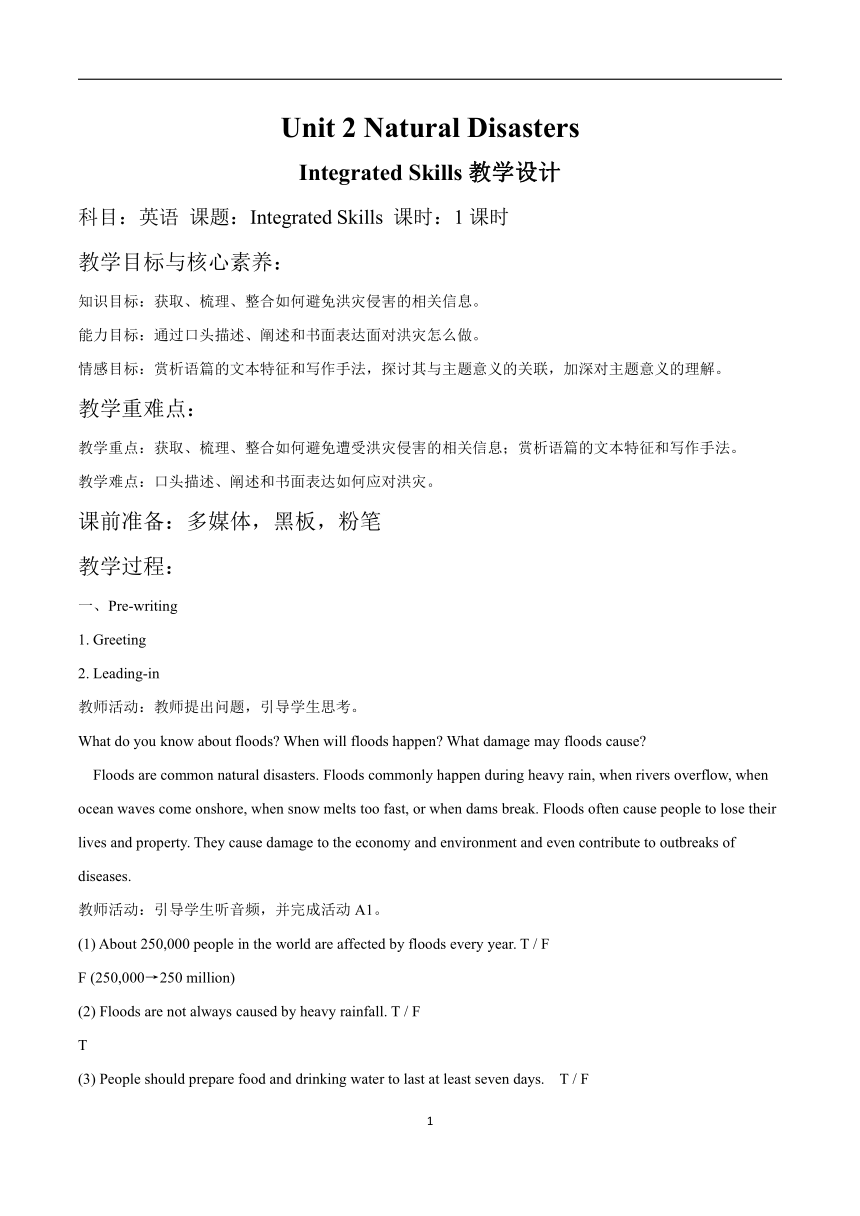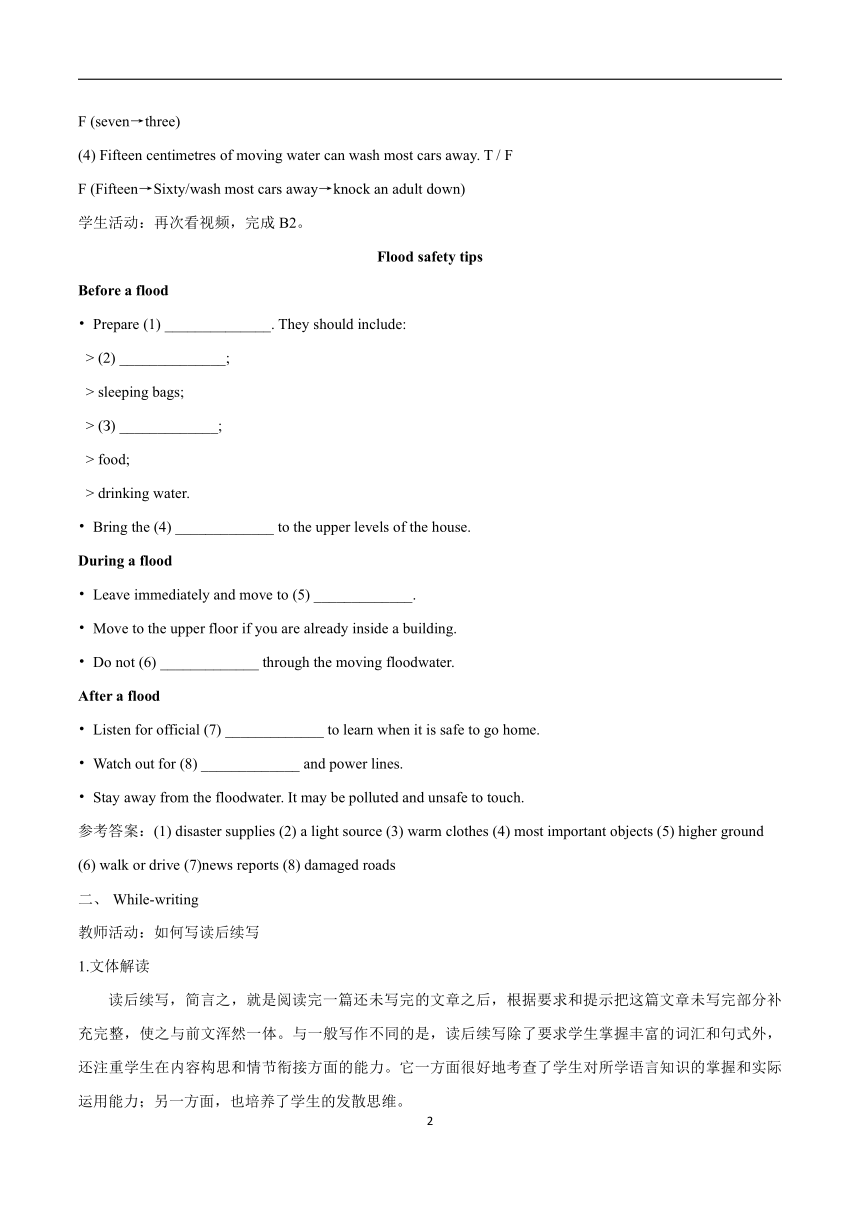牛津译林版(2020)必修第三册Unit 2 Natural disasters Section C Integrated Skills & Extended Reading教案
文档属性
| 名称 | 牛津译林版(2020)必修第三册Unit 2 Natural disasters Section C Integrated Skills & Extended Reading教案 |  | |
| 格式 | docx | ||
| 文件大小 | 32.7KB | ||
| 资源类型 | 教案 | ||
| 版本资源 | 牛津译林版(2019) | ||
| 科目 | 英语 | ||
| 更新时间 | 2022-10-06 16:09:57 | ||
图片预览


文档简介
Unit 2 Natural Disasters
Integrated Skills教学设计
科目:英语 课题:Integrated Skills 课时:1课时
教学目标与核心素养:
知识目标:获取、梳理、整合如何避免洪灾侵害的相关信息。
能力目标:通过口头描述、阐述和书面表达面对洪灾怎么做。
情感目标:赏析语篇的文本特征和写作手法,探讨其与主题意义的关联,加深对主题意义的理解。
教学重难点:
教学重点:获取、梳理、整合如何避免遭受洪灾侵害的相关信息;赏析语篇的文本特征和写作手法。
教学难点:口头描述、阐述和书面表达如何应对洪灾。
课前准备:多媒体,黑板,粉笔
教学过程:
一、Pre-writing
1. Greeting
2. Leading-in
教师活动:教师提出问题,引导学生思考。
What do you know about floods When will floods happen What damage may floods cause
Floods are common natural disasters. Floods commonly happen during heavy rain, when rivers overflow, when ocean waves come onshore, when snow melts too fast, or when dams break. Floods often cause people to lose their lives and property. They cause damage to the economy and environment and even contribute to outbreaks of diseases.
教师活动:引导学生听音频,并完成活动A1。
(1) About 250,000 people in the world are affected by floods every year. T / F
F (250,000→250 million)
(2) Floods are not always caused by heavy rainfall. T / F
T
(3) People should prepare food and drinking water to last at least seven days. T / F
F (seven→three)
(4) Fifteen centimetres of moving water can wash most cars away. T / F
F (Fifteen→Sixty/wash most cars away→knock an adult down)
学生活动:再次看视频,完成B2。
Flood safety tips
Before a flood
Prepare (1) ______________. They should include:
> (2) ______________;
> sleeping bags;
> (З) _____________;
> food;
> drinking water.
Bring the (4) _____________ to the upper levels of the house.
During a flood
Leave immediately and move to (5) _____________.
Move to the upper floor if you are already inside a building.
Do not (6) _____________ through the moving floodwater.
After a flood
Listen for official (7) _____________ to learn when it is safe to go home.
Watch out for (8) _____________ and power lines.
Stay away from the floodwater. It may be polluted and unsafe to touch.
参考答案:(1) disaster supplies (2) a light source (3) warm clothes (4) most important objects (5) higher ground
(6) walk or drive (7)news reports (8) damaged roads
While-writing
教师活动:如何写读后续写
1.文体解读
读后续写,简言之,就是阅读完一篇还未写完的文章之后,根据要求和提示把这篇文章未写完部分补充完整,使之与前文浑然一体。与一般写作不同的是,读后续写除了要求学生掌握丰富的词汇和句式外,还注重学生在内容构思和情节衔接方面的能力。它一方面很好地考查了学生对所学语言知识的掌握和实际运用能力;另一方面,也培养了学生的发散思维。
2.写作要点
根据规定,学生在续写文章时,要注意续写部分“与所给短文及段落开头语的衔接程度”“内容的丰富性”“应用语法结构和词汇的丰富性和准确性”以及“上下文的连贯性”。根据这些规定,我们会发现读后续写有如下特点:
(1)读后续写不是随心所欲,是要在引导语(开头语)的帮助下完成续写部分。如样题中规定“应使用5个以上短文中标有下划线的关键词语(共10处)”。这些关键词语类似于传统写作中的要点提示,如人物、地点、事件,但是不同点在于这些关键词语并不必全用上。这样学生可根据自己的情况,有很大的自主权。另外,所续写部分不能脱离各自段落的首句开头语。这些开头语与传统写作中的开头语类似,在某种程度上引导学生思路的发展方向。
(2)读后续写多以记叙文、故事类文章或者夹叙夹议类文章为主,故事情节曲折起伏,但是,故事的逻辑性比较强。这样学生能够根据提示词语,顺着原来文章的思路续写文章,并适当发散。
(3)读后续写要求读写并重。与阅读理解题一样,读后续写同样需要对本篇文章精确理解,这样所续写部分才不至于偏离主题,就这方面而言有点类似阅读理解题中对文章后续发展的推断,如:What would happen next
(4)所给文章的未完部分的思路和内容并不一定是唯一的,考生可以根据自己对文章的理解,从而对文章的结尾有不同的诠释。
3.续写步骤
(1)精读文章,确定文章线索。每篇文章都有各自独特的写作思路,通过精读文章,找到该篇文章的写作线索,如是以时间为线索还是以空间为线索等,这样有利于学生“顺藤摸瓜(结尾)”。
(2)仔细审题,明确续写要求。一般短文后面的“注意”都有对此次短文续写的具体要求,如:词数限制、使用几处标有下划线的关键词语、续写段落的首句提示,这样学生可以做到“心中有数”。
(3)回扣原文,揣摩续写思路。根据文章后面的要求,再次快速回读短文,抓住文章的思路,结合段首的提示语,最终确定续写段落的思路,同时结合文章画线词语的提示,确定续写段落的内容。
(4)拟写草稿,修改错词病句。在确定了思路和内容之后,最关键的就是结合提示词语或者文中画线的关键词拟写草稿。拟写时,注意句子结构的多样性,语言的丰富性,并通过句与句之间连接词的正确使用,使上下文连贯。
(5)誊写文字,务必做到“字迹工整、清晰”。
三、After-writing
学生活动:学生独立完成文章写作并与同伴互换检查。
教师活动:邀请几位同学展示他们的作品。
四、Summary
总结课上所学。
Learning about the text type
The typical features of a story are the setting, characters and plot. The setting refers to the time, the place and the social and cultural conditions connected with the characters. The characters are usually people or animals. There can be one main character or many in the story. The plot refers to the series of events that happen in the story.
Learning about the structure
At the beginning of your writing, use transitional words or sentences to make connections with the first half of the story. Make sure the second half matches the first half in terms of characters and content.
Learning about the language
Dialogue is important in a story. It can show emotion, move the plot forward and reveal a character's personality. Dialogue is usually placed inside quotation marks.
作业布置:复习本节内容,完成同步练习。
2
Integrated Skills教学设计
科目:英语 课题:Integrated Skills 课时:1课时
教学目标与核心素养:
知识目标:获取、梳理、整合如何避免洪灾侵害的相关信息。
能力目标:通过口头描述、阐述和书面表达面对洪灾怎么做。
情感目标:赏析语篇的文本特征和写作手法,探讨其与主题意义的关联,加深对主题意义的理解。
教学重难点:
教学重点:获取、梳理、整合如何避免遭受洪灾侵害的相关信息;赏析语篇的文本特征和写作手法。
教学难点:口头描述、阐述和书面表达如何应对洪灾。
课前准备:多媒体,黑板,粉笔
教学过程:
一、Pre-writing
1. Greeting
2. Leading-in
教师活动:教师提出问题,引导学生思考。
What do you know about floods When will floods happen What damage may floods cause
Floods are common natural disasters. Floods commonly happen during heavy rain, when rivers overflow, when ocean waves come onshore, when snow melts too fast, or when dams break. Floods often cause people to lose their lives and property. They cause damage to the economy and environment and even contribute to outbreaks of diseases.
教师活动:引导学生听音频,并完成活动A1。
(1) About 250,000 people in the world are affected by floods every year. T / F
F (250,000→250 million)
(2) Floods are not always caused by heavy rainfall. T / F
T
(3) People should prepare food and drinking water to last at least seven days. T / F
F (seven→three)
(4) Fifteen centimetres of moving water can wash most cars away. T / F
F (Fifteen→Sixty/wash most cars away→knock an adult down)
学生活动:再次看视频,完成B2。
Flood safety tips
Before a flood
Prepare (1) ______________. They should include:
> (2) ______________;
> sleeping bags;
> (З) _____________;
> food;
> drinking water.
Bring the (4) _____________ to the upper levels of the house.
During a flood
Leave immediately and move to (5) _____________.
Move to the upper floor if you are already inside a building.
Do not (6) _____________ through the moving floodwater.
After a flood
Listen for official (7) _____________ to learn when it is safe to go home.
Watch out for (8) _____________ and power lines.
Stay away from the floodwater. It may be polluted and unsafe to touch.
参考答案:(1) disaster supplies (2) a light source (3) warm clothes (4) most important objects (5) higher ground
(6) walk or drive (7)news reports (8) damaged roads
While-writing
教师活动:如何写读后续写
1.文体解读
读后续写,简言之,就是阅读完一篇还未写完的文章之后,根据要求和提示把这篇文章未写完部分补充完整,使之与前文浑然一体。与一般写作不同的是,读后续写除了要求学生掌握丰富的词汇和句式外,还注重学生在内容构思和情节衔接方面的能力。它一方面很好地考查了学生对所学语言知识的掌握和实际运用能力;另一方面,也培养了学生的发散思维。
2.写作要点
根据规定,学生在续写文章时,要注意续写部分“与所给短文及段落开头语的衔接程度”“内容的丰富性”“应用语法结构和词汇的丰富性和准确性”以及“上下文的连贯性”。根据这些规定,我们会发现读后续写有如下特点:
(1)读后续写不是随心所欲,是要在引导语(开头语)的帮助下完成续写部分。如样题中规定“应使用5个以上短文中标有下划线的关键词语(共10处)”。这些关键词语类似于传统写作中的要点提示,如人物、地点、事件,但是不同点在于这些关键词语并不必全用上。这样学生可根据自己的情况,有很大的自主权。另外,所续写部分不能脱离各自段落的首句开头语。这些开头语与传统写作中的开头语类似,在某种程度上引导学生思路的发展方向。
(2)读后续写多以记叙文、故事类文章或者夹叙夹议类文章为主,故事情节曲折起伏,但是,故事的逻辑性比较强。这样学生能够根据提示词语,顺着原来文章的思路续写文章,并适当发散。
(3)读后续写要求读写并重。与阅读理解题一样,读后续写同样需要对本篇文章精确理解,这样所续写部分才不至于偏离主题,就这方面而言有点类似阅读理解题中对文章后续发展的推断,如:What would happen next
(4)所给文章的未完部分的思路和内容并不一定是唯一的,考生可以根据自己对文章的理解,从而对文章的结尾有不同的诠释。
3.续写步骤
(1)精读文章,确定文章线索。每篇文章都有各自独特的写作思路,通过精读文章,找到该篇文章的写作线索,如是以时间为线索还是以空间为线索等,这样有利于学生“顺藤摸瓜(结尾)”。
(2)仔细审题,明确续写要求。一般短文后面的“注意”都有对此次短文续写的具体要求,如:词数限制、使用几处标有下划线的关键词语、续写段落的首句提示,这样学生可以做到“心中有数”。
(3)回扣原文,揣摩续写思路。根据文章后面的要求,再次快速回读短文,抓住文章的思路,结合段首的提示语,最终确定续写段落的思路,同时结合文章画线词语的提示,确定续写段落的内容。
(4)拟写草稿,修改错词病句。在确定了思路和内容之后,最关键的就是结合提示词语或者文中画线的关键词拟写草稿。拟写时,注意句子结构的多样性,语言的丰富性,并通过句与句之间连接词的正确使用,使上下文连贯。
(5)誊写文字,务必做到“字迹工整、清晰”。
三、After-writing
学生活动:学生独立完成文章写作并与同伴互换检查。
教师活动:邀请几位同学展示他们的作品。
四、Summary
总结课上所学。
Learning about the text type
The typical features of a story are the setting, characters and plot. The setting refers to the time, the place and the social and cultural conditions connected with the characters. The characters are usually people or animals. There can be one main character or many in the story. The plot refers to the series of events that happen in the story.
Learning about the structure
At the beginning of your writing, use transitional words or sentences to make connections with the first half of the story. Make sure the second half matches the first half in terms of characters and content.
Learning about the language
Dialogue is important in a story. It can show emotion, move the plot forward and reveal a character's personality. Dialogue is usually placed inside quotation marks.
作业布置:复习本节内容,完成同步练习。
2
同课章节目录
- Unit 1 Nature in the balance
- Welcome to the unit
- Reading
- Grammar and usage
- Integrated skills
- Extended reading
- Project
- Unit 2 Natural disasters
- Welcome to the unit
- Reading
- Grammar and usage
- Integrated skills
- Extended reading
- Project
- Unit 3 The world online
- Welcome to the unit
- Reading
- Grammar and usage
- Integrated skills
- Extended reading
- Project
- Unit 4 Scientists who changed the world
- Welcome to the unit
- Reading
- Grammar and usage
- Integrated skills
- Extended reading
- Project
